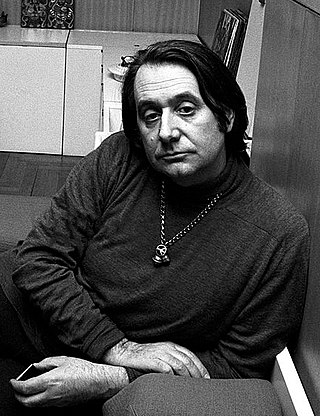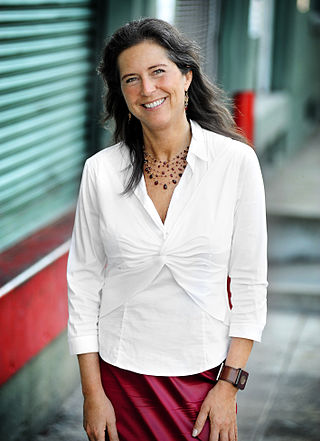Related Research Articles
Parsons School of Design, known colloquially as Parsons, is a private art and design college located in the Greenwich Village neighborhood of New York City. Founded in 1896 after a group of progressive artists broke away from established Manhattan art academies in protest of limited creative autonomy, Parsons is one of the oldest schools of art and design in New York.

Ettore Sottsass was a 20th-century Italian architect, noted for also designing furniture, jewellery, glass, lighting, home and office wares, as well as numerous buildings and interiors — often defined by bold colours.

William Grant Moggridge, RDI was an English designer, author and educator who cofounded the design company IDEO and was director of Cooper Hewitt, Smithsonian Design Museum in New York. He was a pioneer in adopting a human-centred approach in design, and championed interaction design as a mainstream design discipline. Among his achievements, he designed the first laptop computer, the GRiD Compass, was honoured for Lifetime Achievement from the National Design Awards, and given the Prince Philip Designers Prize. He was quoted as saying, "If there is a simple, easy principle that binds everything I have done together, it is my interest in people and their relationship to things."
Vladimir Kagan was an American furniture designer. He was inducted in the Interior Designer Hall of Fame in 2009, 62 years after he started designing and producing furniture.
David Rockwell is an American architect and designer. He is the founder and president of Rockwell Group, a 250-person cross-disciplinary architecture and design practice based in New York City with satellite offices in Madrid and Los Angeles.

Ellen Lupton is a graphic designer, curator, writer, critic, and educator. Known for her love of typography, Lupton is the Betty Cooke and William O. Steinmetz Design Chair at Maryland Institute College of Art. Previously she was the Senior Curator of Contemporary Design at Cooper Hewitt, Smithsonian Design Museum in New York City and was named Curator Emerita after 30 years of service. She is the founding director of the Graphic Design M.F.A. degree program at Maryland Institute College of Art (MICA), where she also serves as director of the Center for Design Thinking. She has written numerous books on graphic design for a variety of audiences. She has contributed to several publications, including Print, Eye, I.D., Metropolis, and The New York Times.

Carlo Ratti is an Italian architect, engineer, educator and author. He is a professor at the Massachusetts Institute of Technology where he directs the MIT Senseable City Lab, a research group that explores how new technologies are changing the way we understand, design and ultimately live in cities. Ratti is also a founding partner of the international design and innovation office CRA-Carlo Ratti Associati, which has offices in Turin, New York and London. He is also a Distinguished Professor in the Department of Architecture, Built Environment and Construction Engineering at the Politecnico di Milano and an Honorary Professor at TTPU Tashkent. Ratti was named one of the "50 most influential designers in America" by Fast Company and highlighted in Wired magazine's "Smart List: 50 people who will change the world".
Charles "Chuck" Harrison was an American industrial designer, speaker and educator. He was the first African-American executive to work at Sears, Roebuck and Company, starting in 1961 as a designer and eventually becoming manager of the company's entire design group. He was involved in the design of over 750 consumer products, including the portable hair dryer, toasters, stereos, lawn mowers, sewing machines, Craftsman power tools, the see-through measuring cup, fondue pots, stoves, and the first plastic trash can, which has been credited with changing the sound of trash collection day. Perhaps his most famous achievement was leading the team that updated the View-Master in 1958, designing the classic Model F View-Master.
Benjamin Fry is an American designer who has expertise in data visualization.
Christoph Behling is a product designer and the founder of Christoph Behling Design, a London-based product design studio established in 2004. Behling is also the founding director of SolarLab Research & Design, a solar-powered transport and architecture company.

Terreform ONE is a 501c3 non-profit architecture and urban think tank that advances ecological design in derelict municipal areas. By formulating unsolicited feasibility studies and egalitarian designs, their mission is to illustrate speculative environmental plans for New York City and other cities worldwide. Their intention is to support community outreach and master plan solutions in underprivileged areas that do not have direct access to qualified architects and urban designers.
Patricia Moore is an American industrial designer, gerontologist, and author. She is one of the founders of the universal design philosophy.

Ward Bennett was an American designer, artist and sculptor. The New York Times described his work as defining "an era."

Ivy Ross is an American business executive, jewelry designer, and, since July 2016, vice president of hardware design at Google. She has worked at Google since May 2014; prior to being appointed VP of hardware design, she led the Google Glass team at Google X. Ross's metal work in jewelry design is in the permanent collections of 12 international museums, including the Smithsonian in Washington D.C. One of few recognized fine artists to successfully cross over into the business world, Ross is also a keynote speaker and a member of several boards, and has been hailed as a “creative visionary” by the art world. In February 2019 she was named one of the 15 Most Powerful Women at Google by Business Insider. In July 2019 she was named #9 on Fast Company's 100 Most Creative People in Business. Ivy is the co-author of the New York Times bestselling book Your Brain on Art: How the Arts Transform Us with Susan Huganir Magsamen. This book shares the science behind humanities birthright - to make and behold art and its power to amplify physical and mental health, learning and build stronger communities.
Max Lamb is a British furniture designer who combines traditional, often primitive, design methods with digital design. He is known for employing unusual approaches to using natural materials, including pouring pewter onto sand, and volcanic rock.
Read Viemeister was an American industrial designer. He was the Creative Director for the Lippincott team working on the Tucker car in 1947, and the founder of Vie Design Studios in Yellow Springs, Ohio.
Jenny E. Sabin is an American architect, designer and artist who draws upon biology and mathematics to design material structures. Sabin is the Arthur L. and Isabel B. Wiesenberger Professor of Architecture in the Department of Architecture at Cornell University. She focuses on design and emerging technologies, with particular emphasis on the areas of computational design, data visualization and digital fabrication.
Rowena Reed Kostellow was an American industrial designer and professor. Alongside her husband, Alexander Kostellow, and other designers and artists, she co-founded the first industrial design education course at Pratt Institute.

Scott Henderson, born April 5, 1966, is an American industrial designer, inventor and television personality who is best known for designing everyday consumer products. He studied industrial design at The University of the Arts under Noel Mayo, D.F.A. (Hon.) and Charles H Burnette, PhD, and began working as a product designer in 1988 when he joined the Sonneman Design Group, in New York City.

Smart Design is a design consultancy based in New York City. Smart was founded in 1980 by industrial designers Davin Stowell, Tom Dair, Tucker Viemeister, and Tamara Thomsen, with Stowell serving as CEO. The firm has been a prominent presence in the design industry since the late 1980s, as design competency increasingly came to be seen as "key to industrial competitiveness".
References
- Smithsonian Cooper-Hewitt, National Design Museum. "Tucker Viemeister". Smithsonian Institution. Retrieved 5 March 2013.
- 1 2 "Tucker Viemeister". Industrial Designer Society of America. Archived from the original on 2012-11-17.
- ↑ "Yellow Springs and The Arts". One Globe Publishing. Archived from the original on 2012-11-25.
- ↑ "Beverly Lipsett Viemeister, obituary". Ancestry.com Board. 2010. Archived from the original on 2012-03-19. Retrieved 2011-05-01.
- ↑ "Shimer-in-Oxford Program". Shimer.edu. Archived from the original on 2012-05-05. Retrieved 2013-06-30.
- ↑ Living Design Innovators. New York. 29 October 2007.
- ↑ "Obituary: SARAH VERDONE". The New York Times . March 21, 2010. Archived from the original on 2012-10-21.
- ↑ "LMCC's Sarah Verdone Writing Award Recipient Emily Rubin receives Award for "Stalina"". Lower Manhattan Cultural Center. November 9, 2011. Archived from the original on 2013-09-16.
- ↑ "2011 Sarah Verdone Writing Award". Lower Manhattan Cultural Center. Archived from the original on 2011-11-20.
- ↑ "Tucker Viemeister: Adjunct Assistant Professor of Communications". Tisch NYU. Archived from the original on 2012-03-24.